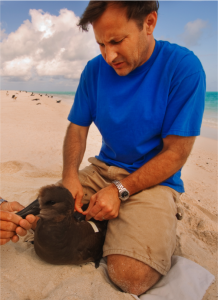By Pat Lopes Harris, Media Relations Director
An unprecedented effort to tag and track sea creatures of all kinds by researchers including Professor of Biological Sciences Scott Shaffer has resulted in discoveries that will help protect and conserve biodiversity.
In Nature June 22, the researchers describe “two vast areas of the north Pacific Ocean, one off the west coast of the United States and the other between Hawaii and Alaska” as “marine counterparts of East Africa’s Serengeti plain. Teeming with life, these oceanic ‘hotspots’ provide major migration corridors for large marine predators ranging from tuna to whales.”
Nature News, an affiliate of the journal Nature, also noted that “knowing where and when species overlap is valuable information for efforts to manage and protect critical species and ecosystems.”
“The new paper is the culmination of a decade-long effort to track the movements of top marine predators in the Pacific Ocean. It provides a remarkable picture of migration pathways and critical habitats for these species,” said the University of California, Santa Cruz, which contributed to the effort.


